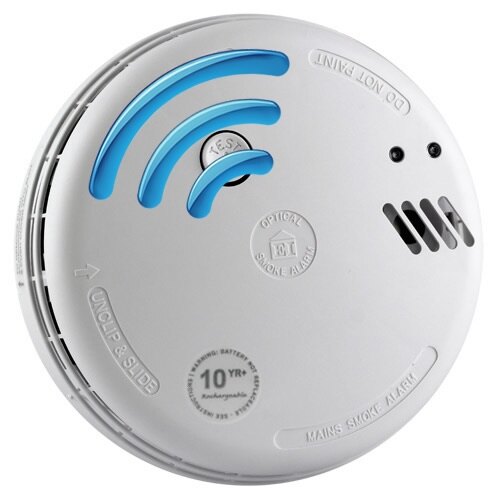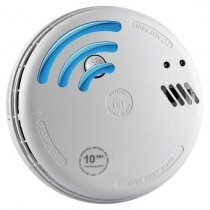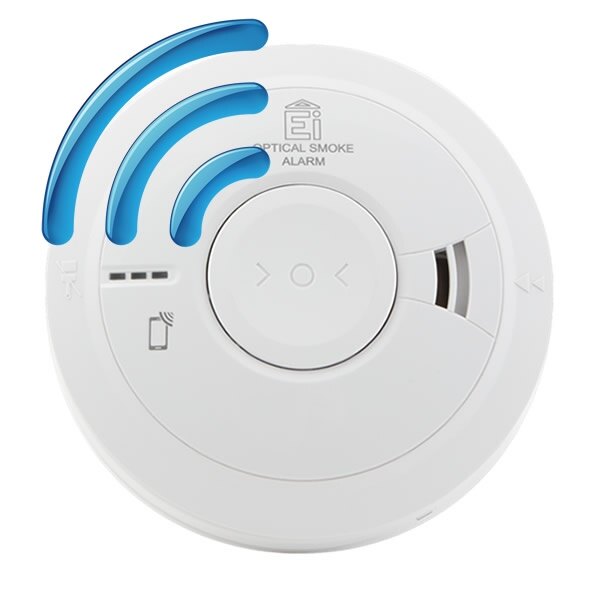-
Contact
Sales & Customer Service
0800 612 6537 support@safelincs.co.uk Live ChatDelivery Enquiries
0800 077 6149 - Resources
Fire & Safety Solutions
CALL OUR TEAM NOW 0800 612 6537
Lines open today 8am - 6pm
Quick Delivery
From £4.19 inc VAT
Live Chat - Online
Instant help & Advice
Trade Discounts
and exclusive pricing
0% Credit Available
Open an account now
5 Star Customer Feedback
Mains Powered Radio-Interlinked Optical Smoke Alarm with Longlife Back-up Battery - Ei166RF
Discontinued Product
This product has been discontinued.
alternative product
Mains Radio-Interlinked Optical Smoke Alarm with Back-up - Ei3016RF
- Power: 230V mains powered with back-up battery
- Backup Battery: Self-charging battery
- Warranty: 5 year warranty
- Supplied with Ei3000MRF SmartLINK module
- Radio-interlink with up to 12 devices
- Extract real time data to their smart phone
- CE and Kitemarked to BS EN 14604: 2005
- Also suitable for both the Welsh and Scottish 2022 legislation
£112.27 inc VAT
£93.56 ex VAT
Product Overview
Carbon Monoxide Alarms
Ancillary Products
Technical Data
FAQs (4)
This mains powered Radio-interlinked optical smoke alarm does not require any cable to connect with other Ei160 series smoke alarms and is ideal for extensions, small let properties and small businesses.
Interconnection
- Mains powered radio-interlinked smoke alarms as a variation of the Ei166 optical smoke alarm
- Each unit consists of a radio-frequency base-plate and the Ei166 optical smoke alarm sensor
- Requires no cables between units
- Can be powered from the nearest light fitting
- Re-chargeable lithium battery backup guaranteed for 10 years for alarm.
- 5 year warranty
- A maximum of 12 units can be interconnected including:
- Kitemarked to BS EN 14604:2005
- Suitable for installations complying to BS 5839-6: 2013 Grade D, E and F
- CE marked
- Requires no cables between units
- Can be interlinked with heat and ionisation alarms
- With test and hush button
- LED display to show correct power supply
- Consists of a radio-frequency base-plate Ei168RC with a Ei166RC smoke alarm fitted to it.
- Can transmit up to 30m in buildings
- Built-in radioLINK repeater function allows for the RF signal to work around obstructions
- Supplied with fixings; 2 x screws and 2 x rawl plugs
The table below shows all the units that can interconnect with the EI168RC/Ei166RC.
Compatible Alarms| Model Number | Type of unit | Type of interconnection |
| Ei168RC/Ei161RC | Mains powered ionisation smoke alarm | Radio-interlinked using the Ei168RC base |
| Ei168RC/Ei164RC | Mains powered heat alarm | Radio-interlinked using the Ei168RC base |
| Ei168RC/Ei2110 | Mains powered multi sensor smoke & heat alarm | Radio-interlinked using the Ei168RC base |
| Ei605TYCRF | Battery powered optical alarm | Radio-interlinked |
| EI603TYCRF | Battery powered heat alarm | Radio-interlinked |
| Model Number | Type of unit | Type of interconnection |
| Ei208WRF | Battery powered CO detector | Radio-interlinked |
| Ei262 | Mains powered CO detector | Radio-interlinked |
| Model Number | Type of unit | Type of interconnection |
| Ei407 | Wireless Manual Call Point | Radio-interlinked |
| Ei411H | Wireless Locate, Hush and Remote test switch | Radio-interlinked |
| Ei412 | Wireless Fire and CO Alarm Control Switch | Radio-interlinked |
| Ei450 | Wireless Fire and CO Alarm Controller | Radio-interlinked |
| Product Code | EI168RC166RC |
|---|---|
| Brand | EI Electronics |
| Back-Up Battery | Rechargeable Lithium |
| Dimensions (HxDia) | 50x152mm |
| Operating Temperature | 0°C to 40°C |
| Relative Humidity | 15% to 95% Relative Humidity |
| Sound Output | 85dB |
| Weight | 0.49kg |
| Product Datasheets |
Q. How do you wire in the Ei140/Ei160 series of smoke alarms?
A.
To wire the units correctly you would use 2 core and earth cable to the first unit and 3 core and earth to the interconnected units. The alarms do not have to be earthed but a brass screw connector is provided so that the earth can be safety terminated.
Q. I have added an Ei168RC164RC wireless linked heat detector to my garage some time after the installation of various other wireless Ei160 detectors in the house. What do I have to do to get the system to recognise the new detector please?
A.
To get the Ei168RC164RC to communicate with the existing alarms, you would need to housecode all the units again. Press the housecode button on the new Ei168RC base and on each of the existing units.
Q. Please could you explain how the repeater function works on the Aico/Ei radio interlinked detectors.
A.
Hello. The radioLINK repeater function allows the smoke alarm to "repeat" the radio frequency signal around obstructions. This stops the signal from becoming blocked and ensures that all interlinked alarms can be reached. This repeater function is built-in to the the Ei168RC radioLINK base (with Ei140, Ei160 or Ei2110 alarm), the Ei600 series of radio interlinked battery powered smoke and heat alarms as well as the Ei262 and Ei208WRF carbon monoxide alarms as standard. When house coded, the system works itself out which alarms are to act as repeaters - it's not something you set up yourself.
Q. For mains powered Aico smoke and heat alarms, when the electricity supply fails and the back up battery takes over, please can you tell me how long the battery will last in this situation?
A.
For mains powered Aico alarms with a new, fully charged lithium back up battery, the battery would last approx. 3-6 months without a mains supply. For mains powered Aico alarms with a standard alkaline back up battery, the battery would last up to a year without mains supply. If the alarm has been installed with an Ei168RC radio frequency base, please note that the Ei168RC back up battery would last approx 2 months if the power fails.
Customer Reviews
2 customers have given this product an overall rating of 4.5 out of 5
Reviews by real customers
All of our product reviews are written by real customers that have purchased this product from us and are published without modification.Rating: 5 / 5 Stars
Reviewed by:
Excellent service from start to finish - thank you
Published on: 27th July 2015
Rating: 4 / 5 Stars
Reviewed by:
product installed and working well.
Published on: 9th March 2014
Looking for more information?
If you have any questions or would like more information about this product you can ask one of our specialists.
Live Chat Available Now
Direct Telephone
01507 464181
























